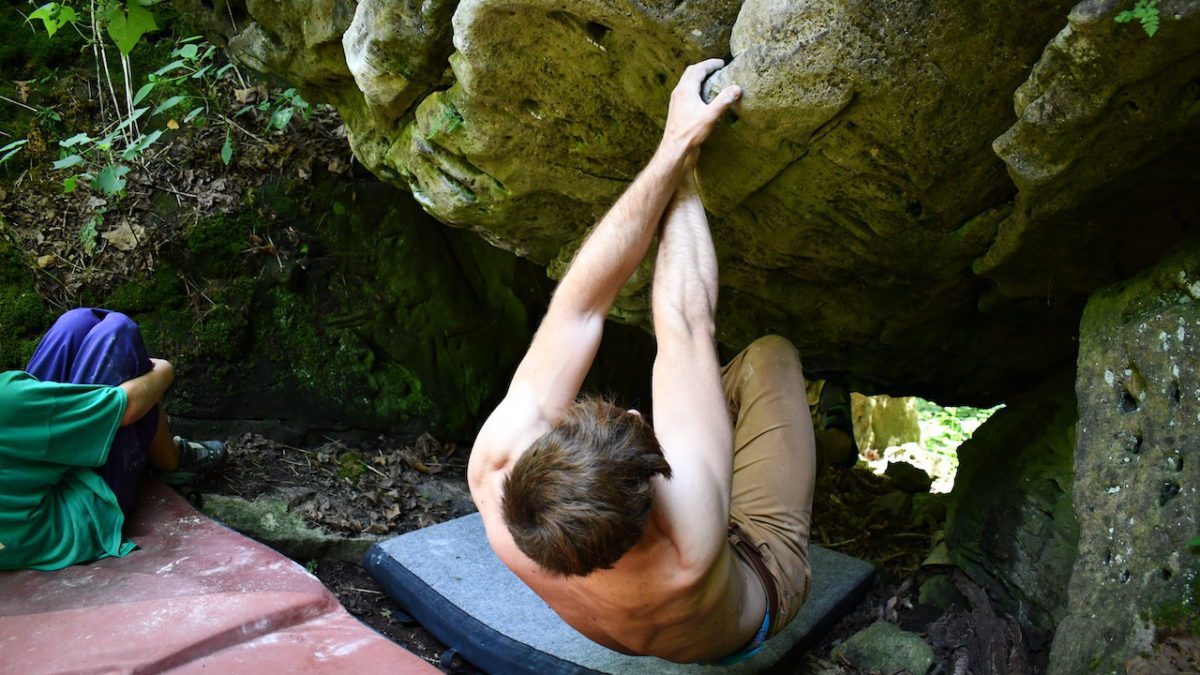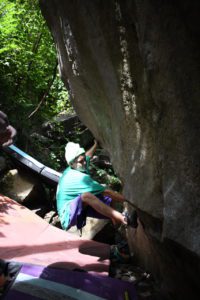Here’s How to Try Hard as a Rock Climber
The best of the best try harder than the rest. How can we begin trying hard for our projects this season?

Trying hard is hard. No matter the difficulty of your level, improving beyond your maximum capability requires more than dedication. In requires a mindset. While some climbers aim to circumvent this problem through training or overtraining, all eventually hit some sort of barrier. A person cannot continue to improve without making the active decision to hit the next hold. Perhaps that seems obvious but pause for a moment. Do you try hard in the gym?
Sure, you work hard. Working hard is easy. Banging out a ton of pull ups, push ups, boulder problems or lead routes each has an obvious level of fatigue associated with it. Unfortunately, fatigue and trying hard do not mean the same thing in a sport as high-powered as climbing.
Improving in climbing comes in many forms, but ultimately physical adaptation must occur to improve beyond a certain point. That said, many athletes have become extremely strong and simply lack the technical know-how to do the move. Today we will discuss trying hard within the physical and technical contexts. If a person can master the method for both, they will have the tools to become an extremely proficient climber. This has greater difficulty than it seems.
Physical
First things first, strength requires strength. Being strong enough or nearly strong enough to do that which holds you back helps a climber attain their goals. A great way to determine whether you may or may not have the ability to complete the climb comes from whether you can hold the positions on your project. Ideally you can do most of the moves and only need to complete the crux to send.

Regardless of whether you have one move left undone, or an eight-move sequence that makes the problem or route feel impossible, the first step remains the same. Can you hold the positions?
If you cannot, then your first step will become trying to hold the position. View this as you might view hangboarding. Take weight off as needed and learn the position. There will be a most accessible method to holding the position. Give a full three to five minutes of rest between attempts and give everything to the movement. Do not consider other projects. They do not exist. Only one focus exists: holding the position.
Once you have learned the position, the next step will become trying the move. Regardless of how far away your hand falls from the next grip, the mentality will be the same: a focused, directed effort. While this last statement has technical connotations as well, we will focus first on the physical.
Imagine you are on your project. First, establish on the move. Next go toward the crux hold. Did you hold something back? Did you allow for further attempts by leaving something in reserve? While this approach has advantages in a longer gym or outdoor session, a projecting session should not concern itself with other boulder problems. At least, the projecting climber cannot approach a move with other boulder problems in mind.

Although we do need to consider the relative stress on our fingers, biceps, hamstrings and other frequently injured tendons and ligaments, we also need to push our bodies toward grabbing holds without hesitancy.
Weighted hangs help with this approach. Due to the extreme difficulty of near-maximum-weight weighted hangs, the climber is forced to physically commit to holding the grip. The alternative exists as failure. Picking a near-max weight for a 7-10 second duration allows the climber to pick something light enough that they can certainly get off of the ground, while still choosing something heavy enough to overcome the challenge of the exercise. In short, weighted hangs facilitate trying hard.
If a person considers the physical stress they put on their fingers in a weighted hangboard session, they will quickly see how infrequently they approach a similar level of stress in their climbing session. Part of this comes down to commercial route setting. Route setting often features comfortable holds that rely more on beta and larger muscle groups than finger strength. By comparison, outdoor projecting features fingery moves on bad holds.
Therefore board climbing becomes so useful for outdoor climbing. It exists at the intersection of hangboarding and gym climbing. Even board climbing will struggle to put a similar weight upon the fingers as the hangboard. Still, it comes closer than most anything else. Together, these two exercises make for a powerful physical combination.
With board climbing, athletes begin to adapt to the difficulty of the problems they are climbing. This is to say that climbers get used to the bad holds and find ways to move technically and efficiently through the standardized holds of their local Moon, Tension, Kilter, or spray board.
While this does mean that the climber’s technique has improved, it also means they have stopped having to try as hard to climb as hard. In these moments, it becomes useful to have a project inside. This forces climbers to move well above their ability. If they wish to make any substantial movement on the block, then they will have to try at a level superior to their normal board climbing difficulty. This is most easily expressed in terms of grades. If a climber generally works, climbs and falls on V6s, a V8 or V9 project well above their level will guide them toward improvement and physical adaptation as the moves will level up to the apex of their ability.
Technical
From a technical perspective, the mentality becomes very full bodied. Return to holding the position. Can you feel each of the places your body has come to rest? Can you feel where your hips are in relation to your hands and your feet? How much weight have you placed through each of the four points? What do you make of these considerations?
Once we can hold a position on a climb, the crux becomes pulling to that position. Once we can hold the position and pull to that position, the crux becomes sticking the hold and body position so as not to fall. Effectively, this means pulling to the point of bodily suspension. Here, there exists almost zero momentum upon the grabbing of the hold.
To achieve this, we must consider the differences in the body positions between the hold we leave and the hold we approach. Then we must consider the necessary hip, foot, and weight shifts required to get from position one to position two. Effectively, the climber must become extremely specific in their consideration of the movement. They must mentally zoom in on the finer details of the beta. At that point, the climber may then combine these micro-betas together to produce a low-strength version of the move. Then they can combine their technical prowess with their physical ability. If their physical ability still outstretches that which the move requires, then they will likely do the move easily. This will make the rest of the boulder possible. This, after all, is the goal.

Considerations
Naturally, trying at this level has difficulties associated with it. First, it requires a lot of rest. Many athletes have trouble with resting. It also requires climbers to refrain from wasting any attempts. It asks every attempt to feature a cognisant approach to movement. This is challenging.
Finally, it asks the climber to grip the holds very hard. This also has difficulties associated with it because it feels like a waste of energy. Instead of viewing it as a waste, instead, think of this as the next step in your training. Trying hard is the mental component of difficult climbing. We must train it like we train the physical components of our ability.
Featured Image by Natalie Chan


